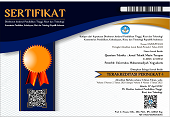Analisis Metode Anodizing Aluminium dengan Variasi Kuat Arus sebagai Material Velg Kendaraan
Abstract
Aluminum Alloy 6061 is widely used in various engineering applications, including automotive vehicle wheels. The selection of aluminum alloy wheels involves aspects such as corrosion resistance. To enhance corrosion resistance, there are several methods, one of which is anodizing. Anodizing is a process that involves an electrolytic coating process that transforms the surface of aluminum into aluminum oxide (Al2O3), which the main process of aluminum anodizing requires a solution of sulfuric acid, chromic acid, or a mixture of sulfuric acid and oxalic acid. The sulfuric acid used must be concentrated acid, and acid is an oxidizing substance. The thickness of the oxide is approximately twice the thickness of the lost aluminum. The purpose of this research is to determine the characteristic such as surface roughness values, corrosion rates, and changes in morphology in Aluminum 6061 after undergoing anodizing. In this study, various current strengths were used, namely 0.75 Amperes, 1.5 Amperes, 2.25 Amperes, and 3 Amperes. The highest surface roughness value was obtained at 0.447 μm in the third specimen of the 0.75 Ampere variation, while the lowest was 0.075 μm in the first specimen of the 3 Ampere variation. The highest corrosion rate was observed in the 0.75 Ampere variation, with a rate of 17.724004 mpy, and the lowest was 0.0731653 mpy in the 3 Ampere variation. SEM results show that, in general, Aluminum 6061 tends to have a bright gray color, which is a surface that has been coated by cathode.
Keywords
Full Text:
PDFReferences
Ak, A. K. W., & Suardana, I. N. 2017. Anodizing Logam Aluminium Dengan Variasi Beda Potensial. Jurnal Pendidikan Kimia Undiksha, 1(1).
Christy, T. V., Murugan, N., & Kumar, S. 2010. A comparative study on the microstructures and mechanical properties of Al 6061 alloy and the MMC Al 6061/TiB2/12p. Journal of Minerals and Materials Characterization and Engineering, 9(1), 57-65.
Hermawan, H., Mulyaningsih, N. and Pramono, C. 2017. Pengaruh Kuat Arus Pada Proses Anodizing Terhadap Karakteristik Velg Mobil Merk Bsa. Journal of Mechanical Engineering, 1(1), 34–40.
Ilham, J., & Haripriadi, B. D. 2019, December. Evaluasi Cairan Pendingin Terhadap Kekasaran Permukaan Pada Proses Milling Cnc Router Aluminium Sheet 1100. In Seminar Nasional Industri dan Teknologi (pp. 191-201).
Marshall, M. B., Lewis, R., Dwyer-Joyce, R. S., Olofsson, U., & Björklund, S. 2006. Experimental characterization of wheel-rail contact patch evolution. Journal of Tribology, 128(3), 493–504.
Nugroho, F. 2014. Pengaruh rapat arus dan waktu anodizing terhadap laju keausan permukaan pada Aluminium Paduan AA 2024-T3. Jurnal Foundry, 4(1), 1-8.
Paz Martínez-Viademonte, M., Abrahami, S. T., Hack, T., Burchardt, M., & Terryn, H. 2020. A review on anodizing of aerospace aluminum alloys for corrosion protection. Coatings, 10(11), 1106.
Salahudin, X., Setiawan, H., & Suharno, K. 2020. Pengaruh Variasi Kuat Arus Listrik Pada Proses Anodizing Terhadap Kekerasan dan Struktur Mikro Permukaan Aluminium. Journal of Mechanical Engineering, 3(2), 1-6.
Santhiarsa, I.Gst.Ngr.N. 2010. Pengaruh Kuat Arus Listrik Dan Waktu Proses Anodizing Dekoratif Pada Aluminium Terhadap Kecerahan Dan Ketebalan Lapisan Jurnal Ilmiah Teknik Mesin CakraM, Vol. 4(1), pp. 75–82.
Syam, A., A, Y., Aziz, A., Syahri, B., & Aliafi, R. 2021. Perbandingan Nilai Kekasaran Permukaan Proses Frais Bahan Aluminium 6061 Menggunakan Endmill Dan Fly Cutter Dengan Variasi Spindle Speed Pada Proses Finishing. Jurnal Vokasi Mekanika, 3(4), 31-38.
Xiaohong, W., Wei, Q., Bo, C., Zhaohua, J., Weiqiang, L., & Weidong, H. 2008. White anodized thermal control coating on LY12 aluminum alloy. Journal of Materials Processing Technology, 200(1-3), 405-409.
Zhenjing, D. U. A. N., Changhe, L. I., Zhang, Y., Lan, D. O. N. G., Xiufang, B. A. I., Min, Y. A. N. G., ... & Xuefeng, X. U. 2021. Milling surface roughness for 7050 aluminum alloy cavity influenced by nozzle position of nanofluid minimum quantity lubrication. Chinese Journal of Aeronautics, 34(6), 33-53.
DOI: https://doi.org/10.18196/jqt.v5i2.21836
Refbacks
- There are currently no refbacks.
Copyright (c) 2024 Quantum Teknika : Jurnal Teknik Mesin Terapan

This work is licensed under a Creative Commons Attribution-NonCommercial 4.0 International License.
Quantum Teknika : Jurnal Teknik Mesin Terapan is indexed by :
Office:
Editorial of Quantum Teknika, Building D, Jl. Brawijaya, Tamantirto, Kasihan, Bantul, Yogyakarta.Telp: (0274) 387656
Fax: (0274) 387646
WA: +62896-7470-8638 (Mirza Yusuf)
Email: jqt@umy.ac.id

Quantum Teknika : Jurnal Teknik Mesin Terapan is licensed under a Creative Commons Attribution-NonCommercial 4.0 International License.
















.png)